Nori Tori Jinbocho Kanda Tokyo Japan Kingyokudo company Art Paintings
Direkt zu den wichtigsten Suchergebnissen
-
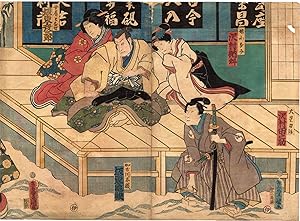
Foto des Verk�ufers
No binding. Zustand: Fair. Utagawa Kunisada (illustrator). Colour woodblock impress on hand laid (verge) paper. Sheet size: 47,v x 34,8 cm. (18,7 x thirteen,7 inch). Paradigm size: 47,5 x 34,8 cm. (xviii,7 x xiii,7 inch).Source unknown, to be determined.Made past 'Utagawa Kunisada' after own design. Utagawa Kunisada (1786-1864) was a Japanese woodblock maker. Also known as Utagawa Toyokuni III (Sandai Utagawa Toyokuni), was the near popular, prolific and commercially successful designer of ukiyo-e woodblock prints in 19th-century Japan. In his own time, his reputation far exceeded that of his contemporaries, Hokusai, Hiroshige and Kuniyoshi. (Source wikipedia) Condition: Off-white, given age. Dog ears below, paper damage in meridian, one hole and tear in newspaper restored, paper doubled with oriental paper. Tape reinforcements. General age-related toning and/or occasional minor defects from treatment. Please written report browse advisedly.Keywords: Nihon-UKIYO-E-ACTORS-Phase-SAMURAIRBOS-T.15-Japanese-large.
-

Foto des Verk�ufers
Zustand: Adept. Utagawa Kunisada (illustrator). Colour woodblock print on hand laid (verge) newspaper. Sheet size: 20 x 32 cm. (7,9 ten 12,vi inch). Image size: 11,five x 10,8 cm. (4,5 x iv,3 inch).Source unknown, to exist adamant.Made past 'Utagawa Kunisada' after own design. Utagawa Kunisada (1786-1864) was a Japanese woodblock maker. Also known as Utagawa Toyokuni Iii (Sandai Utagawa Toyokuni), was the most popular, prolific and commercially successful designer of ukiyo-eastward woodblock prints in 19th-century Japan. In his own time, his reputation far exceeded that of his contemporaries, Hokusai, Hiroshige and Kuniyoshi. (Source wikipedia) Condition: Good, given historic period. Vertical fold in the paradigm from a volume, in passe partout. General historic period-related toning and/or occasional small-scale defects from handling. Please study scan carefully.Keywords: SHUNGA-Nippon-LOVE-MAKING-NUDERBOS-T.xv-Japanese-big.
-
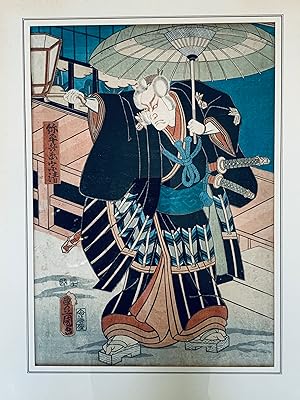
Foto des Verk�ufers
Pas de couverture. - Southward.northward., Southward.l. 1850 (S.d.), 24,2x34,5cm, une feuille. - Estampe originale. Acteur en tenue de seigneur portant une ombrelle (wagasa) et une lanterne. Riche kimono noir, rouge et bleu. Plusieurs cartouches avec inscriptions, dont l'artiste ; la pi�ce et le r�le jou�south par l'acteur sont malheureusement demeur�s ind�chiffrables. Trel bel �tat avec des frottements dans les parties cr�me du sol. 50'estampe se pr�sente sous une Marie-Louise ivoire. Core de h�tre orange verni (41,5x52cm) avec quelques frottements. Sous verre. Utagawa Kunisada (1786-1865), est �galement connu sous le nom d'artiste de Utagawa Toyokuni III. Ma�tre incontest� de l'estampe japonaise, il est l'un des artistes du monde flottant les plus populaires et les plus prolifiques, justement c�l�bre cascade ses repr�sentations d'acteurs kabuki. [ENGLISH DESCRIPTION ON Demand].
-
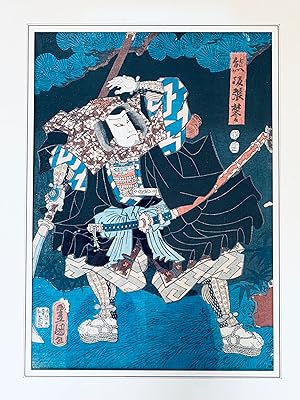
Foto des Verk�ufers
Pas de couverture. - S.north., S.50. 1850 (S.d.), 24,2x34,5cm, une feuille. - Estampe originale. Acteur en tenue de seigneur, en armure, tenant une lance. Riche kimono noir, rouge et bleu. La sc�ne se passe la nuit, fond noir et bleu. Plusieurs cartouches avec inscriptions, dont l'artiste ; la pi�ce et le r�le jou�due south par l'acteur sont malheureusement demeur�due south ind�chiffrables. Trel bel �tat. L'estampe se pr�sente sous une Marie-Louise ivoire. Core de h�tre orangish verni (41,5x52cm) avec quelques frottements. Sous verre. Format Oban de 50'estampe. Utagawa Kunisada (1786-1865), est �galement connu sous le nom d'artiste de Utagawa Toyokuni III. Ma�tre incontest� de l'estampe japonaise, il est l'un des artistes du monde flottant les plus populaires et les plus prolifiques, justement c�l�bre pour ses repr�sentations d'acteurs kabuki. [ENGLISH Clarification ON DEMAND].
-

Inshoku yojo kagami (Rules of Dietary Life) is one of two ukiyoe woodblock prints that are believed to accept been created past Utagawa Kunisada (1786-1864) circa 1850. The other was called Boji yojo kagami (Rules of Sexual Life). Both prints show the inner workings of the human trunk, a schematic that was widely accustomed by the lower class at this catamenia of Japanese history, and both depict organs and processes as being run past small-scale men. This was done to create an easy concatenation of learning. The common people of Japan would learn the believed functions of the organs if they could chronicle their purpose to something they knew. Showing people working, as if trying to run a kitchen, was accessible to the average person. The medium of ukiyoe was a pop art form amongst commoners during the Edo menses and, due to this, was mostly sold and enjoyed amongst the lower and center classes. , Epitome Size : 436x335 (mm), 17.17x13.nineteen (Inches), Platemark Size : , Paper Size : , Printed in Color, Wood Engraving Very Good. Mild wearable. Folded print, flattened. Upper correct corner is provided in facsimile with period manuscript ink.
-
![Bild des Verk�ufers f�r Tokaido gojusantugi no uchi [53 Stations of the Tokaido]. zum Verkauf von Shapero Rare Books](https://pictures.abebooks.com/inventory/md/md30328814742.jpg)
Foto des Verk�ufers
Title page and 55 of 56 prints (lacking the station Goyu), each sheet in chuban tate-e format (25 10 xviii.5cm approx.) Contemporary boards, with fuchsia pinkish decorative endpapers. Utagawa Kunisada (1786-1865) was the most popular, prolific and commercially successful creator of ukiyo-e woodblock prints in Japan in the 19th century. Ukiyo-e flourished from the seventeenth through the nineteenth century. The term translates as 'pic(s) of the floating world', referring to the pleasure-seeking aspects of the Edo menstruation (1600-1867). The subjects of the woodblock prints and paintings included female beauties, kabuki actors, sumo wrestlers, scenes from history and folk tales, and erotica. This beautiful anthology of chuban tate-due east wood block prints (chuban - a impress approximately eighteen x 25 cm; tate - a print in portrait format) includes 55 prints in classic ukiyo-east style with a beautiful lady in front end of a landscape, with near of the landscape designs taken from the Hoeido edition of Hiroshige's The L-three Stations of the Tokaido. The prints are published by either Sanoya Kihei or Moriya Jihei or both, with censor's seal kiwame, all signed (Oju Kochoro / Kochoro/ Oju / Gototei) Kunisada ga, ane print (Fujieda) without publisher's mark(southward) and censor's seal. The 55 stations are: Nihonbashi; Shinagawa; Kawasaki; Kanagawa; Hodogaya; Totsuka; Fujisawa; Hiratsuka; Oiso; Odawara; Hakone; Mishima; Numazu; Hara; Yoshiwara; Kanbara; Yui; Okitsu; Ejiri; Fuchu; Mariko; Okabe; Fujieda; Shimada; Kanaya; Nissaka; Kakegawa; Fukuroi; Mitsuke; Hamamatsu; Maisaka; Arai; Shirasuga; Futagawa; Yoshida; Akasaka; Fujikawa; Okazaki; Chiryu; Narumi; Miya; Kuwana; Yokkaichi; Ishiyakushi; Shono; Kameyama; Seki Sakanoshita; Tsuchiyama; Minakuchi; Ishibe; Kusatsu; Otsu; Miyako Sanjo Ohashi; Kyoto.
-

Foto des Verk�ufers
Zustand: used. A fine ukiyo-e woodcut past the renowned and iconic artist Utagawa Kunisada (1786-1865). The woodcut shows a adult female in a vivid and graphically patterned kimono and obi with a head scarf, peering coyly out the corner of her eye. This image was likely part of a triptych as role of the adjacent image tin can be seen at the left edge and there is a cartouche with kanji, presumably narrating the story line of the triptych.The print is finished with the artist's signature at the left edge and the printer's seal. The epitome is presented in a simple white frame with glazing and a blackness mountain. On washi. Size: Big (thirty-60cm) Framed: Yes Style: Illustration Fine art.
-

Foto des Verk�ufers
Zustand: used. A very fine traditional ukiyo-e woodcut by the renowned and iconic artist Utagawa Kunisada (1786-1865). The print shows a very well known kabuki villain Nikki Danjo in the play Meiboku Sendai Hagi, which involves the tale of a palace intrigue and real events involving the Appointment clan of Sendai during the 1660� south. The play is a classic of kabuki drama, and is this scene a retainer spots the rat and attacks it; information technology escapes just dramatically re-emerges through a trapdoor in the hanamichi (the phase extension into the theatre audience) in the true from of Nikki Danjo and carrying the scroll in his oral cavity. He exits the stage equally if walking magically on clouds.The impress is inscribed with the creative person's signature and publisher'due south seal in the lower right corner and kanji inside cartouches, likely narrating the unfolding scene. The image is presented in a simple white frame with a black mount and glazing. On washi. Size: Large (30-60cm) Framed: Aye Style: Illustration Art.
-

Foto des Verk�ufers
(um 1850). Ma�eastward: ca. 25 cm x 36 cm, mit Schriftzeichen, auf Pappe gezogen, (etwas fleckig/kleiner Randeinri�/leichte Knickspuren am unteren Rand)--- 46 Gramm.
-

Foto des Verk�ufers
Zustand: used. A fine 19th century woodblock print by the well listed Japanese artist Utagawa Kunisada, a prolific and commercially successful designer of ukiyo-eastward woodblock prints. Signature stamped in characters. This print is well presented in a greyness carte mount and a blackness frame. On wove. Size: Large (30-60cm) Framed: Aye Way: Asian.
-

Foto des Verk�ufers
26 cm x 37 cm, (erste H�lfte des xix. Jahrhunderts), Originalholzschnitt auf Japanpapier, (leicht Stockfl./ rechts am Rand minimal hinterlegt)--- 750 Gramm.
-
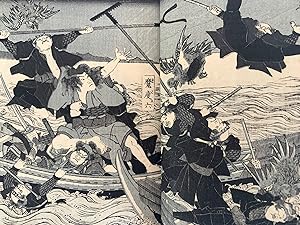
Foto des Verk�ufers
couverture souple. - S.north., Southward.l. 1860 (Due south.d.), 11x5x17,7cm, 22 f., two tomes en un volume cousu. - Edition originale de ce conte. fifteen contes comiques furent publi�s dans cette due south�rie r�unissant l'�crivain Tanezaku et le peintre Utagawa Toyokuni Kunisada. Une illustration couleurs sur double page et papier gaufr�, 2 sur double page � lavis de gris et noir, 15 en noir et blanc sur double page, two simples. Reliure cousue � la japonaise en accord�on. Couverture bleu ciel avec motif de roues et fleurs. Etiquette de titre. Galerie de vers de 1cm sur les 10 derniers feuillets. Salissure au coin gauche correspondant au pouce qui a manipul� les feuillets sur plusieurs pages. Tr�s belle illustration d'un des ma�tres de l'estampe, Kunisada. [ENGLISH Clarification ON DEMAND] 22 f.
-
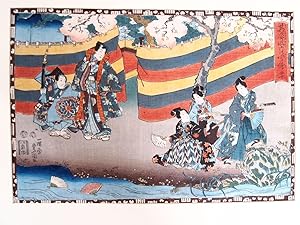
Foto des Verk�ufers
Pas de couverture. - 1854, 23x35cm, Format Oban, une feuille. - Estampe originale imprim�e entre 1847 et 1854. Coup�e apr�s une marge d'un cm. Encadrement moderne r�alis� � Tokyo avec l'�tiquette au dos : Jinbocho Kanda Tokyo. Japan. Kingyokudo & co. Cadre en acajou verni. L'estampe porte un minuscule adh�sif sur une marge qui la relie au passe-partout. Une plaque en polystyr�ne et united nations panneau de bois japonais au dos. De petits rivets pivotants permettent d'acc�der rapidement � la gravure. Un cordon en tissu amovible permet d'accrocher la gravure. L'ensemble se trouve dans united nations embo�tage en carton. Estampe imprim�e sur papier de riz ou de murier. Un pli vertical. Dimension du cadre : 35x50cm. Estampe : 23,5x35cm. Tr�s belle estampe � la mise en sc�ne et aux couleurs raffin�es. Sous un cerisier en fleurs, un seigneur et son �cuyer observent trois femmes au bord de fifty'eau agitant des �ventails ; elles portent toutes united nations sabre. Les tissus des kimonos sont particuli�rement complexes et tr�due south diff�rents. Utagawa Kunisada est l'un des artistes les plus c�fifty�bres et les plus populaires du XIXe si�cle, et �galement l'un des plus prolifiques ; il domine le march� d'estampes durant plusieurs d�cennies. [English language Description ON Need] Format Oban.
-

Foto des Verk�ufers
Album 24 x 37 cm., xl hand coloured woodblock prints, portraits of kabuki actors, original Japanese tanned cloth, concertina binding. Utagawa Kunisada (also known every bit Toyokuni Iii, 1786 1865) was the most popular, prolific and successful designer of ukiyo-e woodblock prints in 19th-century Japan. At the end of the Edo Period (1603 1867), Kuniyoshi (1797-1861) also counted among the best representatives of the Japanese color woodcut in Edo (the then capital city of Nihon). Both artists attended the prestigious Utagawa school, founded by Toyoharu. An album, in the original cloth, containing xl mitt-coloured ukiyo-e, all diptychs. The prints depict various scenes from kabuki plays. A classical Japanese trip the light fantastic toe-drama, sometimes translated every bit 'the art of singing and dancing', Kabuki theatre was known for the stylization and for the elaborate make-upwardly worn past some of its performers. Ukiyo-due east, or ukiyo-ye (pictures of the floating earth), is a genre of woodblock prints and paintings that flourished in Nippon from the 17th through 19th centuries. It was aimed at the prosperous merchant class in the Edo period. Amidst the popular themes were depictions of beautiful women, kabuki actors and sumo wrestlers, scenes from history and folk tales, travel scenes and landscapes, flora and fauna, and erotica. To create a woodblock impress, artists first designed the paradigm on paper and so transferred it to a thin, partly transparent paper. Following the lines on the paper, now pasted to a wooden block normally of crimson forest, the carver used to chisel and cut to create the original in negative with the lines and areas to exist coloured raised in relief. Ink was and then applied to the surface of the woodblock. Rubbing a circular pad over the dorsum of a piece of paper laid over the top of the inked board eventually made the print. Artists like Kunisada and Kuniyoshi were able to produce such brilliant and colourful prints thanks to technological progress. Indeed, in 1765, new applied science had made it possible to produce single-sail prints in a whole range of colours. Polychrome prints were made using a divide carved block for each colour, which could number up to xx. To print with precision using numerous blocks on a single paper sheet, a arrangement of placing ii cuts on the edge of each block to serve equally alignment guides was employed. Newspaper made from the inner bark of mulberry copse was favoured, equally it was strong enough to withstand numerous rubbings on the various woodblocks and sufficiently absorbent to take upwardly the ink and pigments. Reproductions, sometimes numbering in the thousands, could exist fabricated until the carvings on the woodblocks became worn. The nowadays set of prints follows the oban format, which is the most common print size. Information technology corresponds to half a large hosho sheet, in other words nigh 24 x 37 cm.
-
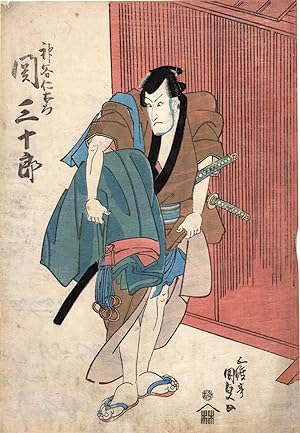
Foto des Verk�ufers
No binding. Zustand: Adept. Utagawa Kunisada or Gototei Kunisada (illustrator). Engraving, block print on paw laid (verge) paper. Canvass size: 25,five x 37 cm. (10 x xiv,vi inch). Prototype size: 25,5 10 37 cm. (10 x 14,6 inch).Sensor: Kiwame (before 1845). Publisher Iseya Rikei (1804-1848).Fabricated by 'Utagawa Kunisada or Gototei Kunisada' after own design. Utagawa Kunisada (Japanese: ?? ??; 1786 12 January 1865), also known equally Utagawa Toyokuni III (?? ?? ?? Sandai Utagawa Toyokuni), was the most popular, prolific and commercially successful designer of ukiyo-e woodblock prints in 19th-century Japan. In his ain time, his reputation far exceeded that of his contemporaries, Hokusai, Hiroshige and Kuniyoshi. Start around 1810 Kunisada used the studio name "Gototei", which refers cryptically to his father'south ferry-gunkhole business. Until 1842 this signature appeared on well-nigh all of his kabuki designs. While growing upwardly, he developed an early on talent for painting and cartoon. His early sketches at that time impressed Toyokuni, the great primary of the Utagawa school and prominent designer of kabuki and thespian-portrait prints. In the year 1800 or shortly thereafter Kunisada was accepted by Toyokuni I every bit an amateur in his workshop. In keeping with a tradition of Japanese primary-apprentice relations, he was and then given the official artist name of "KUNI-sada", the starting time character of which was derived from the second part of the name "Toyo-KUNI". Status: Good, given age. Slight paper loss in upper right corner, repaired, on the reverse Japanese writing on doubled oriental paper. General age-related toning and/or occasional minor defects from handling. Please study scan carefully.Keywords: Actor-DANSABURO-KABUKI THEATRE-UKIYO-E Print-MOSQUITO Internet-SAMURAI SWORDSRBOS-Template sixteen-big.
-

Foto des Verk�ufers
Giappone, 19 secolo (1850ca.). Xilografia originale giapponese su carta, ritocchi a mano all'acquarello. Ben conservata. Inserita dentro cornice artigianale in legno laccato nero. Codice inv.1029896.
-

30x21 cm. 7 Farbholzschnitte. Leporelloalbum mit Stoffeinband. In diesem Leporelloalbum sind seven Holzschnitte im Oban-Format von Utagawa Kunisada (Toyokuni III.) vereint, darunter 2 shini-e (Gedenkbilder) f�r den Schauspieler Ichikawa Dan�r� Eight., der sich im August 1854 in �saka das Leben nahm und dessen Popularit�t die Produktion von ca. 200 dieser Gedenkbilder f�rderte. Bei den anderen f�nf Bildern handelt es sich um Darstellungen von Kabukischauspielern und Szenen aus Auff�hrungen. Dice shini-east und der dritte Holzschnitt sind ohne Signatur, Nr. 4 Toyokuni ga, Nr. 5 Baich�r� Toyokuni ga, Nr. 6 und 7 �ju Toyokuni ga. - (Einband leicht berieben. Textil faserig, minim wurml�chrig. Farben etwas verblasst).
-

Foto des Verk�ufers
Zustand: Near Fine. Utagawa Kunisada (aka Utagawa Toyokuni III) (illustrator). Ii original woodblock prints that create a continuous paradigm when the two are side-by-side. . Impress depicting Ichimura Uzaemon XIII (the samurai on the correct) has paper adhered to the elevation edge of the dorsum of the impress (see epitome). Each print: 9.five x thirteen.75 inches. Shipped through USPS Priority insured mail service.
-

[Edo ca. 1850-56]. Large Oban color woodblock print, 25.6 ten 36.8 cm., splendid image, registry & colour, mended corners, & couple of pivot holes, usual minor surface soiling, scuffing & a bear upon of typical toning, else a very strong prototype. RARE . *** **** *** . . A STUNNING BIJIN [JAPANESE BEAUTY] IN ELABORATE KIMONO . . . WITH A Immature BOY CARRYING ZOORI [SANDALS] . . . THEY PREPARE FOR KAWA-WATASHI [Cross THE RIVER] . . * Typical to Toyokuni III style, this impress depicts a stunning Japanese beauty wearing an elaborate silk Kimono. She is accompanied past a young boy, who carries three pairs of Zoori [sandals]. They are both bare-footed. This work is an excellent depiction of typical Edo menstruation people and costume. . *** THE ARTIST: . UTAGAWA TOYOKUNI Three was really KUNISADA Tsuroda I [1786- -1864], who used some sixteen diverse "Become" [studio names] in his career. He was an Ukiyo-eastward painter, printmaker, who lived & worked in Edo. At age xv, he was a pupil of Toyokuni, eventually taking his master's name, and then Kunisada. In 1807 he produced his first book illustrations, in 1808 he began to brand role player prints. In 1833 he studied nether Hanabusa Ikkei taking the Kohchoroh. In 1844 he took Toyokuni proper name, in 1854 he retired and called himself Shohzoh. Per Roberts: ".his mural prints quite fine." Encounter more biography in Roberts & Lane beneath. . *** Censor. PUBLISHER & CARVER SEALS: At the left lower corner is the Toyokuni III signature in a red cartouche, with the 5 gold balls at the right corner, adjacent to which is the carver's seal. To a higher place this are 2 Kiwame [censor'southward] date and permission seals. At the far correct is the publisher'due south seal. . *** Color photos are posted to our website. . *** Status: This print has a very stiff paradigm, with excellent impression, registry & color. With verso mends to the corners & a couple of tiny mended pin holes. With some of the usual & typical minor surface soiling, scuffing & toning. Else a very fine instance of Kunisada'southward block-signed work. . Ready for matting, framing & display. . *** BIBLIOGRAPHY: . ROBERTS, Laurance P.: A DICTIONARY OF JAPANESE ARTISTS: PAINTING, SCULPTURE, CERAMICS, PRINTS, LACQUER, pp.96-97 * LANE, Richard.: IMAGES FROM THE FLOATING World: THE JAPANESE PRINT INCLUDING AN ILLUSTRATED Dictionary OF UKIYO-E, pp.295-296, plates 516-522; pp. 186-187 & plate 189 . *.
-
![Bild des Verk�ufers f�r SUMO WRESTLER - ORIGINAL 1857 JAPANESE WOODBLOCK PRINT]. Kimenzan Tanigaro zum Verkauf von Michael Laird Rare Books LLC](https://pictures.abebooks.com/inventory/md/md31030698545.jpg)
Foto des Verk�ufers
Broadsheet (364 10 245 mm). Conscience seal is dated "1857 Fourth Month" (� � ). Three horizontal folds, wrinkled, edges frayed, two holes filed with japanese tissue on verso. This is an original woodblock print; Not a reproduction! When Utagawa Kunisada Two (i.e. Toyokuni Iv) made this print, Sumo wrestler Kimenzan Tanigoro (1826-1871) was at the first of his illustrious career. Kimenzan Tanigoro entered sumo in Feb 1852 in the second highest juryo partition and reached the acme makuuchi division in January 1857. In this division he won 143 matches and lost only 24, recording a winning percentage of 85.6. He retired in 1870 and died the next year at the age of 45. He was the 13th sumo wrestler to reach the yokozuna rank. Every bit of July 2021, a total of 73 sumo wrestlers have earned this rank. Toyokuni Iv made another print of this sumo wrestler, which was issued in the same year by same publisher, for which see Ukiyo-eastward Portal Database (National Nutrition Library Acc. No. NDL-1303934). We take been unable to locate another copy of this scarce image, let lone an original woodblock print. We are grateful to Matthew Fraleigh for his translation and enquiry.
-

[Edo ca 1830's, north.p.].Color Oban woodblock print, sail:25.2 x 37.vi cm.,printed in 8 vegetal colors, paper a fleck toned as usual, a few one-time verso mends, now stable & solid, no artist signature, publisher or censor seals, excellent registry. . *** **** *** . . OIRAN: PROSTITUTE VIEW AT NEW YOSHIWARA, EDO . . * This is a typical early on Edo period [1603-1868] portrait of an Edo [sometime Tokyo], Yujo or Oiran, [a prostitute] in elaborate Kimono, with the Obi sash at the front, long pilus pins, wearing tall black-lacquered Pokkuri [tall lacquered wood Geta shoes] commonly worn past this social form of women. . *** The text reads from right to left: "YOSHIWARA EDO MACHI- ICHOME [the most famous address in the Yoshiwara]: Yoshiwara Edo street first block. Followed at the left by IRAIZUMI SENSHU UCHI, the name of the prostitute [or residual house maid]. . *** THE Artist: The piece of work is unsigned simply exhibits characteristics of Toyokuni. [UTAGAWA Kunisada I: 1786-1864] . *** Color photos are posted to our website. . *** Status: The print is printed on laid Washi [handmade] mulberry paper. There is some of the usual and typical for this age piece some paper 'toning.' The image has excellent impression and registry, clearly an early pull off the blocks. . There are some old mends to the back side, along the right margin, and at the corners, where it was 'pinned' up in ancient times. Nevertheless the prototype is strong and pleasing, ready for matting, framing and display. . *.
-

2 japanese- and english-titled matted cardboard-boxes, each containing a heavy gently illustrated colour-cloth box, which again comprise 4 paper-thin folders with a total of 99 tipped-in colour-plates and an illustrated clothbound textbook of 70 unnumbered pages each; big-Folio (ca. 48 10 36 ten 14 cm; ca. 12,7 kg.). *** [Letztmalig ERWEITERTER FR�HLINGS-VERKAUF / Ultimately EXPANDED SPRING-SALE: UM fast l% REDUZIERTER PREIS bis Montag 09.05.2022, 24 Uhr (PRICE-REDUCTION until Monday, May 9th, 12 p.one thousand.); urspr�nglicher Preis / originally: EUR 1.650,-] --- FIRST EDITIONS, LARGESIZE LUXURIOUSLY EQUIPPED ORIGINALS; THE Consummate Serial of this awe-inspiring publication. - The cardboard-boxes with minimal shelfwear; CLOTHFOLDERS AND CONTENT IN Best CONDITION.
Source: https://www.zvab.com/buch-suchen/autor/kunisada-utagawa/
0 Response to "Nori Tori Jinbocho Kanda Tokyo Japan Kingyokudo company Art Paintings"
ارسال یک نظر